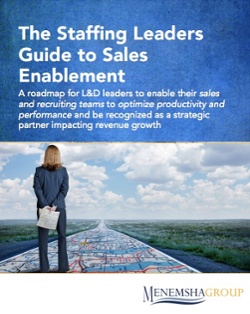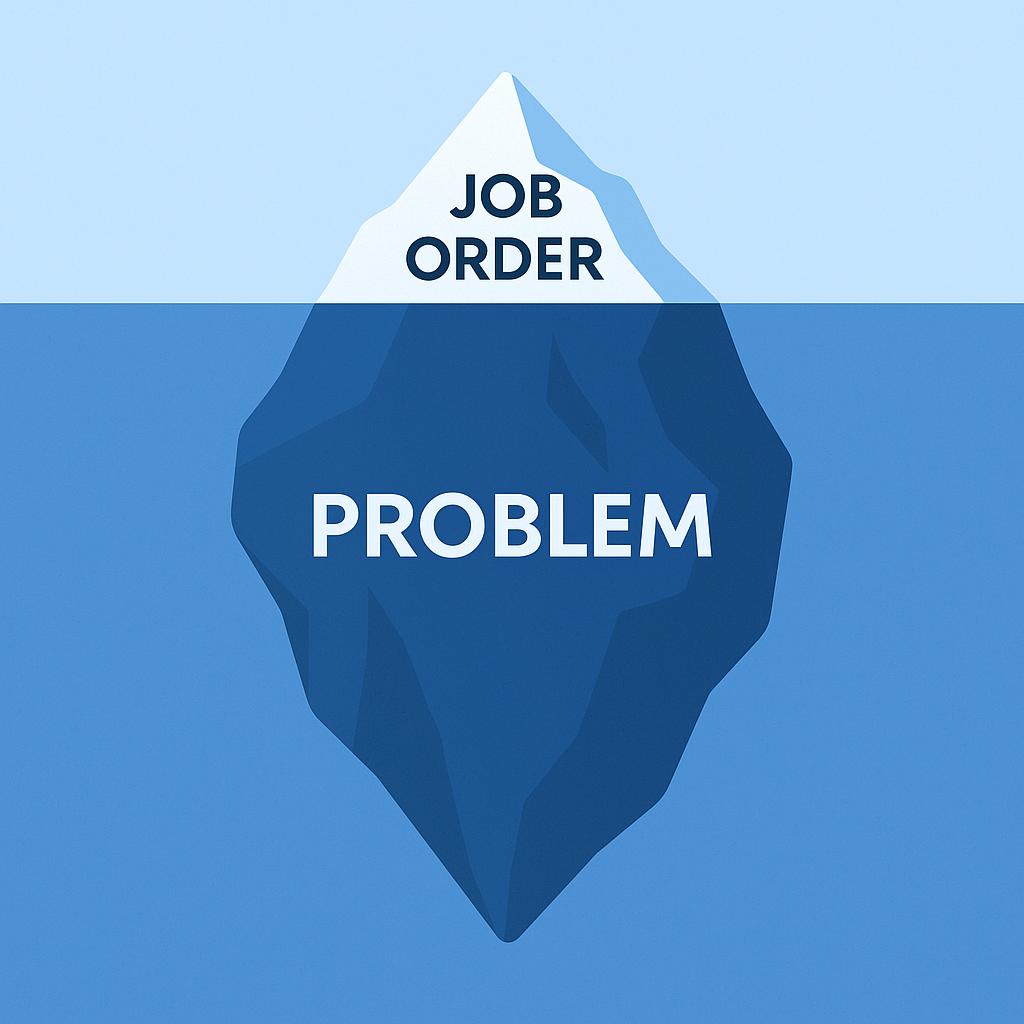Selling With Your Consultant
In my previous post, How to Prevent Unexpected Contract Terminations, I shared how systemizing consultant and client check-ins at key milestones...
5 min read
![]() Dan Fisher
:
Dec 18, 2024 9:06:01 AM
Dan Fisher
:
Dec 18, 2024 9:06:01 AM

Sales teams need content to close deals. More specifically, content that enables them to ask relevant questions, share relevant insights, address buyers’ concerns, demonstrate expertise, provide in-depth product or service knowledge, and demonstrate how you make an impact for your customers.
Great content drives great conversations and closes deals.
Gartner includes ‘content’ as one of the key categories in its Sales Enablement Framework. Though the importance of sales enablement content is evident, 78% of the buyers claim that the salespeople do not provide them with the relevant content they need.
The problem is that sellers don’t have the time or the skills to research, design, and create the enablement content needed to address buyers' pain points and concerns.
In this blog I will explain what sales enablement content is and why you need it.
What is Sales Enablement Content?
Sales enablement content are the resources, content, and tools that help sales teams effectively communicate value to prospects and customers across each stage of the buyer’s journey. Sales enablement content is both customer-facing content (marketing materials, presentations, digital sales rooms (content), self-guided demos, explainer videos, case studies) and internal content (scripts, playbooks, rebuttal books, messaging frameworks, templates, battlecards, etc.).
presentations, digital sales rooms (content), self-guided demos, explainer videos, case studies) and internal content (scripts, playbooks, rebuttal books, messaging frameworks, templates, battlecards, etc.).
Sales enablement content may also include buyer enablement content, materials designed to support customers in making purchasing decisions such as ROI tools, business case frameworks, cost justification tools and tools for gaining consensus across a buying team.
These materials, often developed by marketing teams, are designed to educate, engage, and move prospects through each stage of the buyer’s journey—from awareness to consideration to decision-making to closing the deal.
The key is that they provide sales reps with the information they need to personalize their conversations to the prospect’s needs, address objections, and ultimately drive deals forward.
Effective sales enablement content plays a critical role in a company’s ability to move a prospect from one stage of the sales cycle to the next and close deals.
The Value of Sales Enablement Content
Salespeople move up the relationship spectrum by adding valuable insights and perspective during each interaction with prospective buyers and customers. But not every interaction is verbal. Offering the right message or piece of content at the right time is what keeps the value flowing, and maintains deal momentum, especially when the seller isn’t sitting across the table from the prospect.

To be successful at helping customers move forward, salespeople need internal and customer facing enablement content for each phase of the buyer’s journey.
For example, customers in the awareness stage of the buyer’s journey are primarily focused on recognizing they have a problem or a goal, and trying to understand its nature and put it into context. They research the problem and basic information about potential solutions. They are not yet considering specific brands, vendors or products, but are simply trying to identify and define their issue, often through online research and speaking with colleagues and thought leaders.
For sellers, the goal is to help the buyer identify and articulate their problem. At this stage, they might sense that something isn’t working but they can’t fully define it or put their finger on it. It is the job of the salesperson-with the help of sales enablement content-to provide educational content that helps them put a name to the challenge and better understand its impact. For example, an article titled “Data Governance: A Guide to Managing Enterprise Risk" might help a technology leader reduce risk by developing a data governance strategy. It helps them see their issue and potential solutions more clearly.
Sales Enablement in Action
Samantha, a bright and eager sales representative for an IT staffing firm, recently found herself in a conversation with a highly engaged buyer, Sarah Johnson, Director of Data Management for a Fortune 1000 company. Sarah was sharing with Samatha her key priorities for the upcoming year including a critical data warehousing initiative, a project that would require external resources from a third-party in a multitude of areas including data architecture, data cleansing, and ETL (Extract, Transform, Load) processes.
From the start, Sarah was open and transparent, outlining the project’s goals and overall scope. However, because Samatha lacked the knowledge of knowing what relevant questions to ask, she was unable to engage in deeper discovery. instead, she launched into a pitch about how her company has placed data engineers, database developers and DBAs with skills such as Oracle, SQL, SSIS and Tableau.
Sarah acknowledged Samatha’s statements but quickly moved on to explain that data cleansing and a data de-duplication effort would be a key aspect of the project. She continued by explaining that inaccurate, duplicate data is causing issues in workflows, reporting, and decision-making and that duplicate customer records were resulting in inconsistent communication and errors in service delivery.
This opened the door for Samatha, her golden opportunity to demonstrate her expertise and establish her firm as a trusted partner by doing any of the following; asking inquisitive questions to further diagnose Sarah's issues and demonstrate credibility, teach Sarah something new by sharing a relevant, non-obvious insight or perspective, or share a relevant customer case study. Instead, Samatha asked “do you have a job description you can share with me?” and “when will you be looking for these people to start?”
Sarah looked at Samantha with a puzzled look on her face. This was the 'Aha' moment for Sarah, the moment she realized she was carrying the conversation, carrying the problem, and—ultimately—carrying the responsibility for the solution. Sarah was expecting Samatha to respond with inquisitive questions, a fresh perspective or insight that she had not yet considered. It was disappointing and deflating.
In that moment Sarah realized that Samatha is not someone who can help her move forward, innovate, or achieve her goals. A quiet frustration settled in, but also clarity: this rep is not the guide she were hoping for.
Sarah nodded at her watch and informed Samatha that she had to run to her next meeting. Samatha pushed for a follow-up meeting but Sarah politely declined. As they wrapped up Sarah requested additional information about Samantha’s firm and relevant capabilities.
Samantha got back to her desk and slumped in her chair, feeling frustrated she had missed a golden opportunity. But she still had hope because Sarah asked for more information, and she had promised to follow up quickly. But instead of confidently sending the right materials, Samantha spent days scrambling to figure out what content to share.
Samantha sifted through outdated folders, half-baked presentations, old data sheets and marketing literature trying to cobble together something that spoke to Sarah’s needs. She even spent several hours of her own time trying to create content from scratch, pulling together company information and information from the web.
Samantha finally sent a generic, high-level company overview document it was a full week later. The excitement from the initial conversation had fizzled, and the delay sent a clear message to the customer: her firm wasn't ready to deliver. Samantha followed up with multiple voicemails and emails, hoping to reignite the opportunity, but the silence on the other end was deafening.
How Enablement Content Could Have Driven Deal Momentum and Helped Samantha
Tailored Messaging Frameworks
Sales enablement content could have provided Samantha with messaging frameworks tailored to data warehousing including ETL, data architecture and data cleansing. This would allow her to confidently speak to:
Relevant Case Studies and Success Stories
With access to case studies of past data warehousing projects, Samantha could have demonstrated her firm’s expertise and built Sarah’s confidence. For example:
Sales Playbooks
Internal enablement content, such as a data warehousing playbook would have allowed Samantha to ask deeper discovery questions. She could have uncovered Sarah’s pain points (e.g., tight timelines, lack of internal expertise) and positioned her firm’s services as the ideal solution.
Buyer-Enablement Content
With a project of this magnitutde, Sarah will likely need to build internal consensus. Buyer enablement content to support Sarah would have benefited Samatha, including
Conclusion
Sales enablement content is not just “nice to have”—it is essential for sales success. Sales enablement content keeps the value flowing which drives deal momentum. It also:


In my previous post, How to Prevent Unexpected Contract Terminations, I shared how systemizing consultant and client check-ins at key milestones...

About a year ago, I was serving as the fractional revenue leader, managing sales and recruiting for a client.

If you’ve worked in staffing long enough, you’ve been trained to chase job orders.